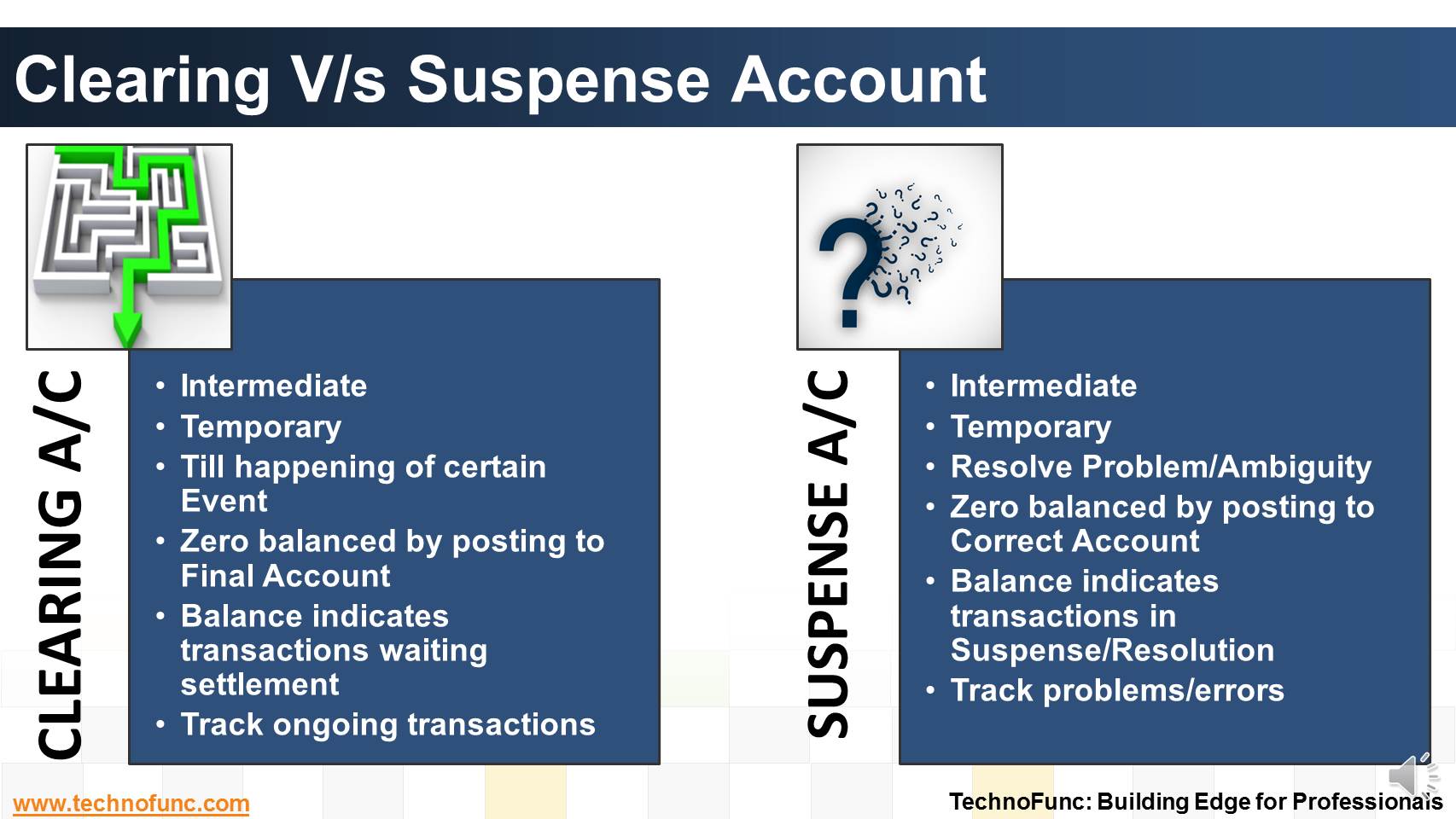- Home
- Business Processes
- Industry Knowledge
- Aerospace Industry
- Automotive Industry
- Banking Domain
- BFSI Industry
- Consumer/ FMCG Industry
- Chemicals Industry
- Engineering & Construction
- Energy Industry
- Education Domain
- Finance Domain
- Hospitality Domain
- Healthcare Industry
- Insurance Domain
- Retail Industry
- Travel and Tourism Domain
- Telecom Industry
- Leadership Skills
- eLearning
- Home
- Functional
- Cash Management
- Clearing V/s Suspense Account
Clearing V/s Suspense Account
Suspense and clearing accounts resemble each other in many respects but there exists important fundamental difference between the two. Read more to explore these differences.
Suspense and clearing accounts resemble each other in many respects but there exists one important fundamental difference.
Both are temporary accounts. Transactions are entered and finally transferred to the appropriate account.
Suspense and clearing accounts have entirely different functions.
Clearing accounts are used to hold transactions for later posting and ensure information is recorded correctly and completely.
A suspense account is used when there appears to be a problem. It serves to record an amount until the problem is resolved.
Both suspense and clearing accounts are "zeroed out" periodically. This means everything in an account is moved to other accounts, leaving a zero balance.
Suspense A/c is used for tracking Uncertainties – to hold transactions when there is some ambiguity involved.
For example, customer has deposited payment in the bank account and you are unable to identify the customer from available information,
You can put the transaction in a suspense account until you determine where it belongs.
Whereas Clearing Accounts are used for tracking transactions on a temporary basis until it's time to post them to a more permanent account.
Taking the same example, now the customer has sent payment against many outstanding invoices and you know it belongs to a particular customer but not to which invoice.
This may be parked in a clearing account until the confirmation is received from customer and amount applied to correct invoice.
Just to keep track of correct outstanding past due invoices.

Related Links
You May Also Like
-
Before we dive into cash management, let us fist understand what we mean by cash and what constitutes cash in context of cash management process.
-
The topic for this lesson is "Introduction to Cash Management Process". We start with the learning objectives for building requisite functional expertise in cash management process.
-
The Cash Management component ensures that the enterprise has sufficient liquidity for payments that are due and to monitor payment flows. Learn how treasury plays an important role in cash management for the enterprise.
-
Have you ever wondered what is actually a Bank Statement and why it is needed. What is the information that is available in a bank statement?
-
So many codes in the lines that are there in a Bank Statement. It contain lots and lots of meaningful information that can help automated many tasks. Explore more!
-
Account Reconciliation – How? Learn the three key attributes to perfom account reconciliation.
-
Suspense and clearing accounts resemble each other in many respects but there exists important fundamental difference between the two. Read more to explore these differences.
-
Treasury Management - Functions
Treasury management has become an specialized function. Treasury function helps in managing the Risk-return profile as well as the tax-efficiency of investment instruments. In larger firms, it may also include trading in bonds, currencies and financial derivatives. Learn about the various tasks, activities and imperatives, undertaken by treasuries in in today's context.
-
Bank reconciliation process is targeted to validate the bank balance in the general ledger and explain the difference between the bank balance shown in an organization's bank statement. Learn the reasons for existence of differences between the two.
-
In automated clearing, Bank statement details are automatically matched and reconciled with system transactions. Learn how this process works and what are the perquisites to enable the same.
Explore Our Free Training Articles or
Sign Up to Start With Our eLearning Courses

About Us
Learning
© 2023 TechnoFunc, All Rights Reserved











